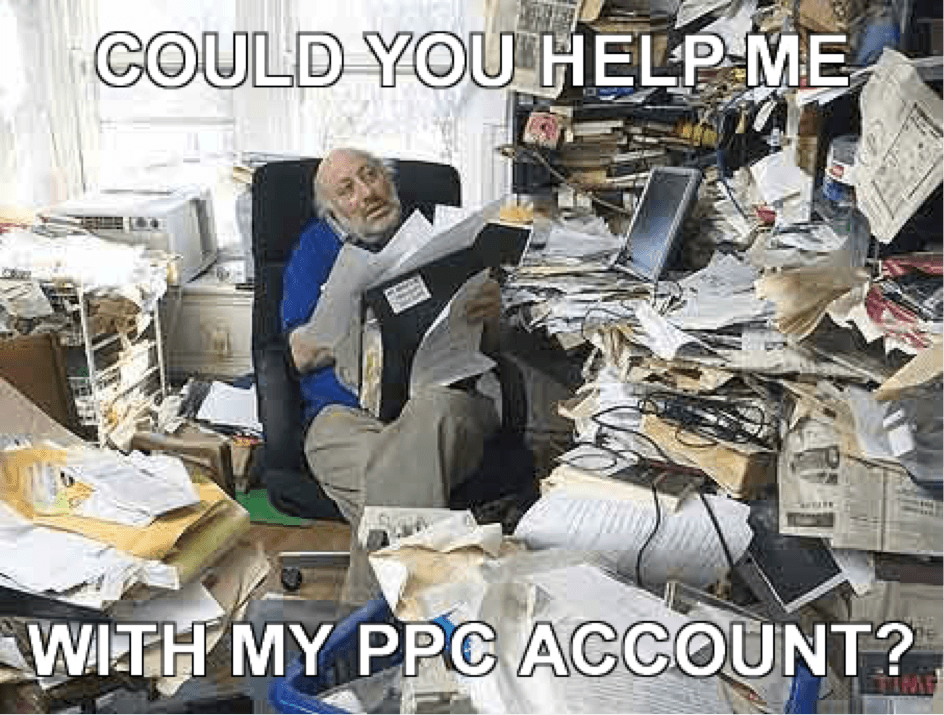The Complete Guide to PPC Audits
by Jacob Baadsgaard • June 18, 2015
PPC audits are all about opportunity.
Yep, you heard me right. While the word “audit” typically merits comparisons to medieval torture, PPC audits are all about discovering unrealized opportunities. Let’s face it, no matter how good you are at PPC, there’s always something you could be doing better.
PPC audits help you find that something.
So, without further ado, let’s take a step back and look at what’s going on with your accounts. What’s working? What isn’t?
Let’s figure out how to take things to the next level.
Why Are You Using PPC?
First things first. One of the biggest mistakes online marketers make is focusing on irrelevant metrics. Ultimately, the only metric that matters is the profitability of the business. Sure, CPC, CTR, CPA and the rest of the acronym soup are good indicators, but CTR doesn’t pay salaries.
With any PPC audit, I recommend hauling out the old marketing calculator. Does the business case for PPC still add up? Consider the following:
What are you trying to achieve with your PPC campaigns?
Your objectives need to be clear and profit-driven. Newsletter sign-ups should lead to income in a definable way. Ecommerce sales should grow while maintaining decent margins. Sales leads should convert at an acceptable rate. Whatever the reason for your PPC campaign is, it’s important to make sure that you are achieving that goal in a way that benefits your bottom line.
Example: If your goal is lead generation, you need to make sure that your lead conversion rate is high enough to justify the your cost per lead. A $5 CPA may look great; but, if your sales team only converts 1 out of 100 leads, you need to make at least $500 profit per sale just to cover marketing expenses. That might add up, it might not.
What Has Changed?
Online marketing is anything but static. Costs change. Market interest changes. Search terms change. Competition changes. And the list goes on… Not only do you need to accommodate for changes in your campaigns, you also need to account for those changes in your overall online marketing strategy.
Example: Continuing the previous scenario, a new competitor enters the market and the two of you start duking it out for top spot. Your CPA jumps to $7.50. Fortunately, you make $800 profit per sale before marketing expenses; but, at the new CPA, does PPC still make sense?
If the business case for online marketing doesn’t add up, that’s a hard stop. Do not pass go, do not collect $200. You need to take a hard look at the situation and decide if PPC is really worth the investment. In many cases, you can make more progress by looking at the big picture than you can by hashing out the details.
Analytics
Seriously, you’re not using analytics?

Okay, so you probably are using analytics, but you’d be surprised how many companies don’t take advantage of this essential resource. Sure, PPC platforms give you a few tools that monitor CTR, conversions and a smattering of other metrics, but that’s just the beginning.
If you’re using Google AdWords, it’s easy to link your account to Google Analytics. From there, you can start to look at metrics like average time on site or bounce rate to determine what happens after someone reaches your landing page.
At Disruptive Advertising, we have a mantra:
PPC + CRO + Analytics = ROI
In other words, the key to making your online marketing campaigns successful (ROI) is optimizing every step in the process. It’s hard to produce good PPC and CRO without good analytics. In essence, analytics is the key to translating PPC audit shortcomings into actionable opportunities.
If you’ve got analytics up and running, then use that data! If not, I’m gonna keep on laughing…
Let’s Get Down to Business
Okay, now that you’ve got your business case and your analytics put together, it’s time to take things up a notch. With any analysis, it’s important that you are looking at a representative set of data. At a minimum, you probably want to look at least 3 months of data for a specific concern; however, generally speaking a year or more of results is best.
At Disruptive Advertising, we offer clients a free 32-point PPC audit that builds off of the following list to help us identify key improvement opportunities. To date, we haven’t met anyone who aced everything, so dig in!
1. Account Structure
A disorganized account makes data analysis both meaningless and practically impossible. If the campaigns don’t have some sort of rhyme or reason (hopefully not your fault), you need to get in and sort things out. Ideally, ad group names should give context to the campaigns inside. A PPC audit is kind of like a crime scene investigation, the “who, what, where, when and how” give you a frame of reference.
- Who are you marketing to? (pregnant women, 49ers fans, etc.)
- What are you marketing? (nausea bands, fan gear, etc.)
- Where are you marketing? (the east coast, San Francisco, etc.)
- When are you marketing? (early mornings, Monday nights, etc.)
- How are you marketing? (morning sickness, coolest man cave, etc.)
Odds are, at least one of these is an important part of your campaign. Add it to the campaign name! If you find yourself asking, “now what am I looking at here?” you probably need to reevaluate your naming convention.
Organizing your account is critical to determining what factors give you a good ROI. Remember, you can’t learn from chaos.
2. Networks
Make sure you know what your campaigns are up to. One slip of the mouse and they’ll take off with your money.
Look at the Network Settings for your campaigns. Are you targeting both Search and Display networks with the same campaign? Don’t do it!
If you are running a display network campaign, look at your placements. Most of the time, you should at least have some managed placements. If you don’t, now’s a good time to find some. If you do, check and see how they are performing. Placements that don’t perform should be excluded, winners may deserve extra time and attention.
It’s hard to meet your core objectives if you aren’t running your campaigns in the right spots. Always check to see if your money is going to the right place.
3. Targeting
Location targeting is an often-missed opportunity to cut down on irrelevant clicks. You might have the world’s most brilliant campaign; but, if you’re advertising a local spa to the whole country, you’re probably wasting a lot of money.
On the flip side, if you find that you are more successful in certain locations or that some ad groups or keywords perform better in a given area, you may want to create campaigns dedicated to that location (check the Geographic report). At the very least, you can increase your bids for those areas to ensure that you aren’t outranked.
Overall, using location targeting can be a great way to reduce costs and increase the effectiveness of your campaigns. It’s an easy kill that can quickly put more money in the bank.
4. Keywords
Now we’re getting to the meat of the audit. Keyword selection is the lifeblood of PPC. However, anyone who has tried PPC knows that successful keywords aren’t always the terms you expect. Given the importance of keywords to your campaign’s success, it’s always worth taking a long, hard look at your choices to ensure that everything is adding up appropriately.
Assuming you have the right terms, here are 4 ways to get more out of your keywords:
1. Search Term Report
There are a lot of ways the wrong search can end up triggering your ad. The Search Term Report can help you identify weaknesses in your keyword strategy. Keep an eye out for one-word, broad-match keywords; exact-match negative keywords; and irrelevant long-tail keywords.
2. Negative Keywords
The right negative keywords will save you money. Period. Take a look back up at that Search Term Report and find all of the searches that trigger your ads but don’t trigger results. If you’re looking for some quick kills, Techwyse has a helpful list of terms you should mark as negative keywords for different account types.
3. Grouping
Grouping keywords correctly can do wonders for a variety of metrics. Good keyword grouping allows you to write highly relevant ads and landing pages that maintain search continuity. In other words, your ad only triggers when a search is relevant to the ad. The ad contains the search term the user is looking for. And, so does the landing page.
Group your keywords appropriately and this should be a piece of cake.
4. Custom Bids
Your bids should be tailored to what works. There are quite a few ways to do this, but ultimately you want to spend most of your money on the things that make you the most money. Look at which keywords sell and assign your bids accordingly.
5. Ads
Good ad copy is incredibly important. As with keyword selection, a thorough review of PPC ad development and psychology is beyond the scope of this guide (see here for some good pointers); but, there are a few things you should definitely watch out for:
1. Message Mismatch
As mentioned previously, PPC works best when you have an unbroken trail from intent to conversion. If your ad matches what the searcher is looking for, they’ll probably click on it. For this reason, ads typically perform well if the ad copy includes some or all of the keywords that triggered the ad.
Note, dynamic keyword insertion can be helpful here, but you have to pull it off right. At this point, people are pretty wary of advertisements, so “Want to DIY Bookshelves?” probably won’t generate many clicks. If you’re going to use dynamic keyword insertion, make sure the resulting ads don’t throw up red flags.
2. Poor Grammar or Spelling
Your ad says a lot about your product. If your grammar and spelling is shoddy, people will assume your offering is also shoddy. After all, if you don’t care enough to do your sales pitch right, what are the odds you do a good job on anything? First impressions are critical in marketing, don’t waste your impressions on a typo.
3. Dangling Description Lines
If you use it right, description line 1 can really work to your advantage. If you make the top of the page, description line one moves up to your headline—provided that the line ends with a period. Work that feature! Not only does it make whatever you say in line 1 look better (see previous point), it also gives you more headline real estate. Double win!
It should go without saying, but good ads sell good. Rewriting bad ad content is always a good way to improve your CTR, quality score and, ultimately, your bottom line.
Props to you if you caught the grammatical error in that last paragraph…
6. Quality Score
A lot has been written about how keyword quality score affects your campaigns (for a really interesting article on the relationships between quality score and various metrics, click here). Regardless of where you stand on the quality score debate, improving your quality score reduces your cost-per-click.
A big part of the quality score debate, of course, is the time it takes to improve your quality score. If you’re looking for a win in this area, don’t expect results overnight. Quality score is essentially determined by how well your ad and site meet customer needs over time, so look at your keyword selection, ad relevance, landing page content and click-through-rate to get an idea of whether or not your ad is succeeding.
In my opinion, a good quality score is the result of good marketing. If you are reaching your target audience correctly, both your business and your quality score should naturally improve (which both saves and makes you money!).
7. Extensions
In today’s competitive online marketing environment, extensions have become something of a must. First off, if you’re fighting for top spot, extensions give you a lot more real estate. Second, they focus your clicks on what your customers really want to see. That’s another double win!
Successful extensions, however, require a bit of planning and work. Ask yourself, Which extensions best fit my marketing goals? Put a location extension up for an online retailer and you might as well just post a CTA titled “Click Here to Give Google My Money.” If a call extension is set to run 24/7, but the company only takes call from 9 to 5, you’re setting the stage for a lot of missed opportunities.
Do it right, and setting up extensions can have significant effects on the profitability of an online marketing campaign.
8. Remarketing
Check your remarketing campaigns. If you don’t have any, consider adding some. Retargeting can be a great way to cheaply pull potential customers back to your site. After all, if they visited your site before, they are much more likely to visit again (and hopefully convert this time).
If you are running remarketing campaigns, look at your audience selections (under Shared library) and make sure they are all collecting members. Double-check that you have designated audiences for each level of abandonment. Lastly, make sure you’ve put the right cookies with appropriate lengths in your website code.
Retargeting tends to be an easy online marketing option to neglect, but ensuring that your campaign is running appropriately is an easy way to increase conversions without breaking the budget.
Summary
At their core, PPC audits really are all about finding actionable opportunities to make more money. Whether it’s putting together the business case for PPC, monitoring analytics data or implementing a fix that makes your account sing, watching your efforts turn into dollars is just plain fun.
If you’re interested in having someone else audit your account, let us know! We’d be happy to audit your accounts and give you a free review of what’s working, what isn’t and where you can improve.
You’ve heard my two cents, now I want to hear yours:
Where have you seen the biggest opportunities in your PPC accounts? Is there anything you would add to this PPC audit list?







